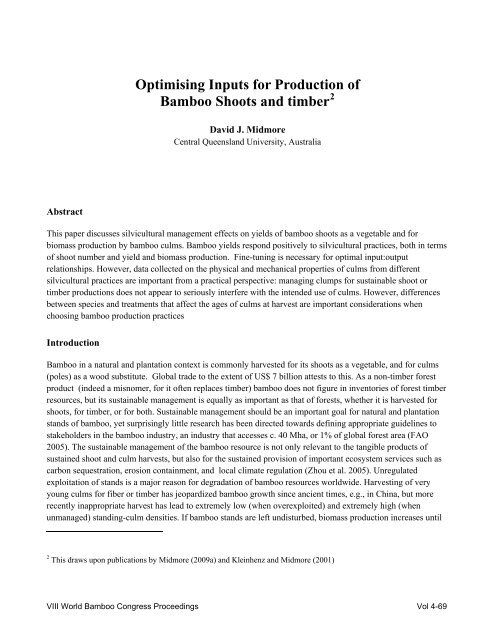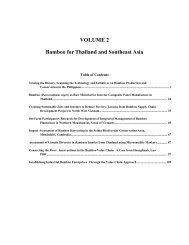WBC-VIII-Vol.4 – Resources – Forestry, Plantations and ... - BambuSC
WBC-VIII-Vol.4 – Resources – Forestry, Plantations and ... - BambuSC
WBC-VIII-Vol.4 – Resources – Forestry, Plantations and ... - BambuSC
You also want an ePaper? Increase the reach of your titles
YUMPU automatically turns print PDFs into web optimized ePapers that Google loves.
Abstract<br />
Optimising Inputs for Production of<br />
Bamboo Shoots <strong>and</strong> timber 2<br />
David J. Midmore<br />
Central Queensl<strong>and</strong> University, Australia<br />
This paper discusses silvicultural management effects on yields of bamboo shoots as a vegetable <strong>and</strong> for<br />
biomass production by bamboo culms. Bamboo yields respond positively to silvicultural practices, both in terms<br />
of shoot number <strong>and</strong> yield <strong>and</strong> biomass production. Fine-tuning is necessary for optimal input:output<br />
relationships. However, data collected on the physical <strong>and</strong> mechanical properties of culms from different<br />
silvicultural practices are important from a practical perspective: managing clumps for sustainable shoot or<br />
timber productions does not appear to seriously interfere with the intended use of culms. However, differences<br />
between species <strong>and</strong> treatments that affect the ages of culms at harvest are important considerations when<br />
choosing bamboo production practices<br />
Introduction<br />
Bamboo in a natural <strong>and</strong> plantation context is commonly harvested for its shoots as a vegetable, <strong>and</strong> for culms<br />
(poles) as a wood substitute. Global trade to the extent of US$ 7 billion attests to this. As a non-timber forest<br />
product (indeed a misnomer, for it often replaces timber) bamboo does not figure in inventories of forest timber<br />
resources, but its sustainable management is equally as important as that of forests, whether it is harvested for<br />
shoots, for timber, or for both. Sustainable management should be an important goal for natural <strong>and</strong> plantation<br />
st<strong>and</strong>s of bamboo, yet surprisingly little research has been directed towards defining appropriate guidelines to<br />
stakeholders in the bamboo industry, an industry that accesses c. 40 Mha, or 1% of global forest area (FAO<br />
2005). The sustainable management of the bamboo resource is not only relevant to the tangible products of<br />
sustained shoot <strong>and</strong> culm harvests, but also for the sustained provision of important ecosystem services such as<br />
carbon sequestration, erosion containment, <strong>and</strong> local climate regulation (Zhou et al. 2005). Unregulated<br />
exploitation of st<strong>and</strong>s is a major reason for degradation of bamboo resources worldwide. Harvesting of very<br />
young culms for fiber or timber has jeopardized bamboo growth since ancient times, e.g., in China, but more<br />
recently inappropriate harvest has lead to extremely low (when overexploited) <strong>and</strong> extremely high (when<br />
unmanaged) st<strong>and</strong>ing-culm densities. If bamboo st<strong>and</strong>s are left undisturbed, biomass production increases until<br />
2 This draws upon publications by Midmore (2009a) <strong>and</strong> Kleinhenz <strong>and</strong> Midmore (2001)<br />
<strong>VIII</strong> World Bamboo Congress Proceedings Vol 4-69




